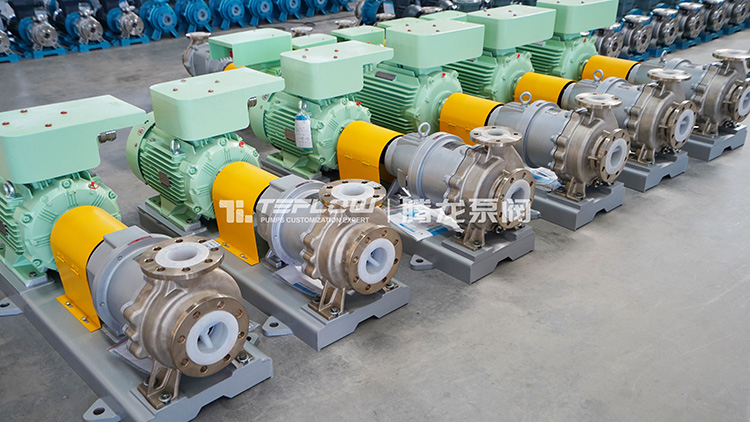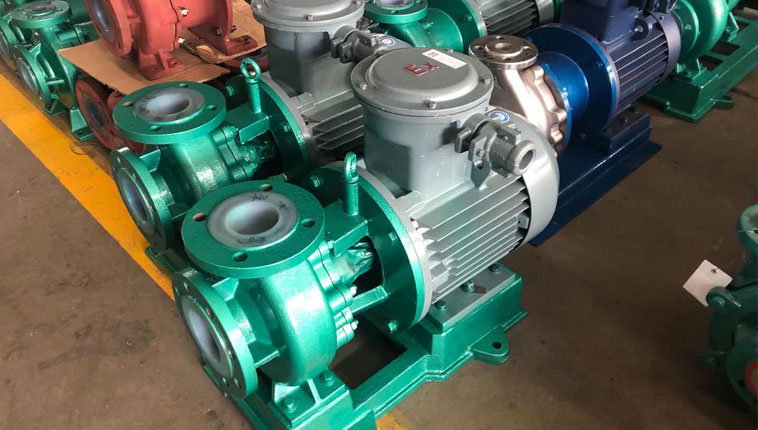In industrial sectors involving the transportation of highly corrosive media, such as petrochemicals, acid and alkali production, and non-ferrous metal smelting, PTFE-lined magnetic drive pumps have become core equipment due to their leak-free operation and excellent corrosion resistance. Although steel-lined PTFE magnetic pumps and cast iron-lined PTFE magnetic pumps both belong to the category of PTFE-lined magnetic pumps and both use fluoroplastic linings for the flow parts to resist corrosion, there are significant differences in their performance limits and applicable scenarios due to the inherent differences in the base materials (steel and cast iron).

1.Higher structural strength, stronger pressure resistance and impact resistance
The mechanical properties of the base material directly determine the structural load-bearing capacity of the pump body, which is also the core advantage of the steel-lined PTFE magnetic pump. Cast iron materials inherently possess defects such as high brittleness, low tensile strength, and poor impact resistance. When subjected to high pressure or encountering fluctuations in working conditions, they are highly susceptible to structural failures such as cracks and breakage. Steel possesses excellent tensile strength, toughness, and fatigue resistance. Using steel as a base material, a PTFE-lined magnetic pump can form a more stable structural support.
In addition, the good toughness of steel makes it far superior to brittle cast iron in dealing with the impact of media and the instantaneous stress generated by equipment start-up and shutdown. In the transportation of corrosive media containing small solid particles (such as acid leaching solutions in the smelting industry), steel-lined PTFE magnetic pumps can better resist the scouring and impact of particles on the pump body, reducing the risk of lining detachment due to damage to the base material.
2.Superior corrosion resistance and stability, extending equipment lifespan.
Although both types of pumps use fluoroplastic linings for their flow parts to isolate corrosive media, the difference in corrosion resistance of the base material directly affects the overall service life of the equipment. Cast iron itself has poor corrosion resistance. Even with fluoroplastic lining protection, once the lining is damaged due to long-term wear, installation errors, or media erosion, corrosive media will quickly penetrate into the cast iron base, causing the base to rust and decay. The volume expansion caused by rust will further damage the integrity of the lining, forming a vicious cycle of "lining damage - base corrosion - more severe lining damage", leading to frequent equipment scrapping and replacement.
The steel substrate (especially carbon steel or stainless steel that has undergone anti-corrosion treatment) has a certain degree of corrosion resistance. Even if the lining is damaged in a localized manner, the steel substrate can resist the erosion of the medium for a certain period of time, thus providing a buffer time for equipment maintenance. Meanwhile, the surface smoothness of steel is higher, and its bonding strength with the fluoroplastic lining is far superior to that of the cast iron substrate, which can effectively reduce the gap between the lining and the substrate and reduce the risk of media penetration. In highly corrosive environments such as acid and alkali production, steel-lined PTFE magnetic pumps have an average service life of 3-5 years, while cast iron-lined PTFE magnetic pumps typically have a service life of only 1-2 years, and the frequency of repairs due to corrosion is significantly higher in the later stages.
It is worth noting that the stability of the steel matrix can also improve the high-temperature resistance of the lining. When conveying high-temperature corrosive media, the cast iron matrix has a large thermal deformation coefficient and is prone to thermal stress separation from the lining; while the steel matrix has better thermal stability and can form a more stable bond with the PTFE lining, enabling the steel-lined PTFE magnetic pump to adapt to higher temperature conditions and further expanding the applicability of the equipment.
3.More reliable operation, reduced maintenance costs and downtime losses
Industrial production places extremely high demands on the continuity of equipment operation. Downtime caused by equipment failure often results in huge economic losses. Steel-lined PTFE magnetic pumps, thanks to the advantages of their base material, demonstrate significant advantages in operational reliability and maintenance cost control.
From a structural stability perspective, steel has far superior material uniformity compared to cast iron. Cast iron is prone to internal defects such as porosity and sand holes during the casting process. These defects can lead to problems such as vibration and excessive noise during pump operation, and long-term operation can also accelerate the wear of critical components such as bearings and magnetic couplers. In contrast, the steel-lined PTFE magnetic pump has a uniform base material, better dynamic balance performance, and lower vibration and noise during operation. This not only reduces the impact on surrounding equipment but also slows down the wear rate of critical components and reduces maintenance frequency.
4.It has a wider range of applications and is suitable for complex and demanding working conditions.
The application scenarios of PTFE-lined magnetic pumps are limited by the performance of the base material. Steel-lined PTFE magnetic pumps, with their advantages in strength, corrosion resistance and stability, can be adapted to more complex and harsh industrial conditions, while cast iron-lined PTFE magnetic pumps are mostly limited to the transportation of simple low-pressure corrosive media.
In the petrochemical industry, steel-lined PTFE magnetic pumps can ensure safe transport in high-pressure reaction systems and for conveying strong oxidants (such as hydrogen peroxide). In the transport of high-temperature acid leaching solutions (temperatures can reach above 100℃) in non-ferrous metal smelting, the thermal stability of the steel matrix can effectively prevent the lining from falling off. In the transport of high-precision corrosive reagents in the pharmaceutical industry, its low-vibration operation can ensure flow stability and avoid reagent waste or uncontrolled reaction.
As industrial production upgrades to complex operating conditions such as high pressure, high temperature, and high corrosion, and as environmental protection and safety requirements become increasingly stringent, steel-lined PTFE magnetic pumps demonstrate irreplaceable advantages due to their structural strength, corrosion resistance, stability, and operational reliability. When selecting a pump, companies should consider their specific operating needs to ensure safe, stable, and efficient production.





 +86 18130251359
+86 18130251359 teflowpumps@tlpumps.com
teflowpumps@tlpumps.com











 +86+0563-5093318
+86+0563-5093318
